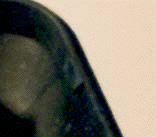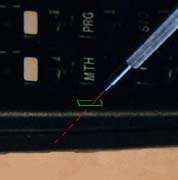

The only obstacle is the snap-together "hooks" that David Holmes refers to. These hooks are positioned near the [A], [F], [SIN], [1/x], [ON], [+] and [.] keys (the one by the [.] key is a real bugger!). Refer to the cutaway diagram below for details.
Key overlay here ___
\ ____________
\ | |
____________| ______ |
| _ | | <--- Upper section.
| | | | |
________________| | | |_|
| | |___
Circuit board and other | | |
components (affixed to | / | <--- Lower section.
upper section) |/__ | Has a lip which
| | | engages with metal
Metal "hook" ---> | / | | "hook" from upper
|/ | | section.
| | |
________________| | |
| |To separate the two sections, you will need to push the lower
section out and down around the hooks. You can't do this from
the outside because the upper section hangs over the lower, so
you have to go from the inside. Luckily, the six slots in the
keyboard (used by the separate user-overlays that fit over the
original overlay) near the [MTH], [ENTER], [blushift], [NXT],
[backspace] and [-], come in handy for this. These slots are not
exactly lined up with the hooks, but are close enough. You can
insert something in these holes (I used a jewelers screwdriver,
flat head) at an angle that is mostly down and somewhat out, to
a depth of about 5mm, and come in contact with the lower section.
Push the lower section out about 2mm (this will take a bit of
force), while wedging something in the outside gap to separate
and hold the sections apart while working on the other hook positions
( a wooden matchstick works). I recommend starting with the [A]
or [F] positions first, working down whichever side you started
with, then do the other side, and leave the [.] position for later
(there is no helpful slot there).
 |
 |
| The two battery contacts which come through the case will need to go back through the case when the sections separate. The upper contact is hooked on a plastic boss, and needs to be freed from it. Just pop it off with your finger or a screwdriver. |  |
